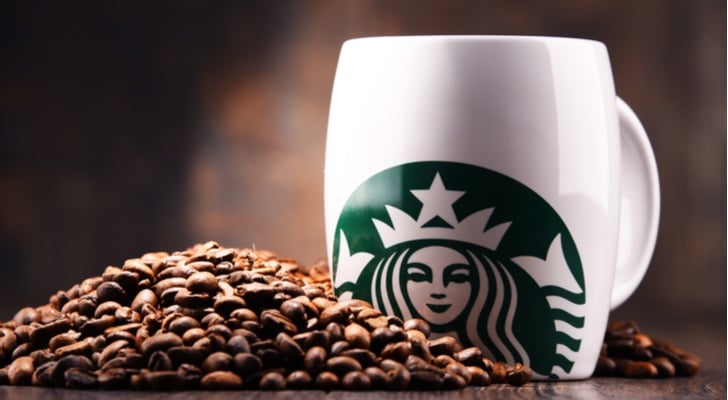Starbucks (NASDAQ:SBUX) stock may have pulled back from recent highs, due to the ever-increasing volatility in the stock market. The more fearful investors get, the more likely they are to sell solidly run companies like SBUX. The astute investor needs only look at the company’s healthy profit, revenue, and gross margins to see that Starbucks stock is still a buy.
Despite a favorable product mix that lifted growth in the quarter, SBUX investors do have one thing to worry about. Starbucks is expanding rapidly in China but if trade tensions keep escalating, a full-on revolt against U.S-based companies could hurt near-term prospects.
A Strong Fourth Quarter for SBUX
In its fiscal fourth quarter, Starbucks reported a non-GAAP operating gross margin of 42.7%. This already includes a 150 basis point headwind from costs associated with its Nestlé transition. That, plus the divestiture of Teavana and the sale of Tazo to Unilever (NYSE: UN) will lead to even stronger profitability.
Starbucks succeeded in growing earnings by 17% year-over-year, to $2.42 a share. The impressive results validate the company’s streamlining initiatives are paying off. Geographically, China is the coffee giant’s second-largest and fastest growing market. It furthered its expansion there by partnering with Alibaba Group (NYSE: BABA). While Japan and Korea added positively to results, China is still a central part of the company’s growth ambitions in Asia.
Starbucks Still Has U.S. Growth
Even as it tends to global expansion plans, Starbucks still grew revenue in the Americas by 8%, to $4.3 billion. Strengthening the in-store experience, developing mobile app drink orders, and innovating beverages are all paying off. Mobile Order and Pay, drive-through and out-the-window all did well, growing by more than 50%. Customers like the ease and convenience of putting orders in this way.
New drink types are also resonating with customers. Cold Brew and Refreshers, plus the Nitro offering, are now at 700 more stores. By the end of 2018, it will have a store reach of 2,800.
And Starbucks got ahead of the festive season by running holiday-driven specials one week earlier than usual. This should lead to better-than-expected revenue growth when the company reports this quarter’s results sometime in February 2019.
Growth in China
Starbucks reported strong revenue growth of 41% in the China-Asia Pacific region in Q4, and 38% for the fiscal year. SBUX benefited from opening 585 net new stores and entering 17 new cities over the last 12 months. In Q4 alone, it added 139 stores. At 3,500 stores across 148 cities in China, Starbucks is clearly expecting strong growth in the country.
However, although Starbucks has not yet experienced any slowing demand, the sentiment against U.S.-based companies could start if the two countries do not resolve trade differences.
Canada already felt the sting when it arrested prominent Huawei executive Meng Wanzhou — at the request of the U.S. China responded by boycotting goods made by Canada Goose Holdings Inc. (NYSE: GOOS). This sent GOOS stock from $70 down to $40 in the last two months. It has not happened yet but if the Chinese government finds some reason to encourage citizens to boycott Starbucks and other U.S. iconic brands, SBUX stock will suffer.
But take these boycott risks with a huge grain of salt. On December 31, Canada Goose opened a new flagship store in Beijing, and the store was packed. GOOS rose 8% on the day as a result. There is also the risk of tariffs on the U.S.-based company for Chinese customers, however.
Upside Outweighs Risks
For now, investors may safely assume for now that Starbucks will continue thriving in China. Its partnership with Alibaba and its exposure on all of Alibaba’s ecosystem — Tmall, Alipay, and Taobao, for example — is creating a unique digital experience for customers. Starbucks has already expanded its delivery program at all its stores in Beijing and Shanghai, and in 11 cities in China. By the end of this year, Starbucks Deliver will be in over 2,000 stores across 30 cities.
The Bottom Line for Starbucks Stock
Wall Street analysts have a $69.20 price target on Starbucks stock.
At a valuation of under 20x trailing P/E, Starbucks stock is not expensive relative to its future growth potential. When the company reports first-quarter results, strong holiday sales worldwide should impress investors once again. The report should have enough good news to send the stock back to 52-week highs.
Disclosure: the author does not own shares in any of the companies mentioned.

